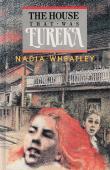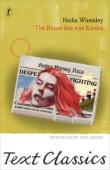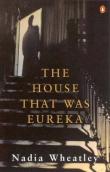AustLit
The material on this page is available to AustLit subscribers. If you are a subscriber or are from a subscribing organisation, please log in to gain full access. To explore options for subscribing to this unique teaching, research, and publishing resource for Australian culture and storytelling, please contact us or find out more.
Latest Issues
AbstractHistoryArchive Description
'It’s 1981 and Evie is sixteen. She has left school but can’t find work, and her family has just moved into the run-down inner Sydney suburb of Newtown. Noel lives in the adjoining terrace house. He’s fifteen, not taking school seriously and fed up with looking after his ancient bed-ridden grandmother.
'As a friendship grows between Evie and Noel, the past is set back in motion, and the events of the 1930s Depression era begin to play out in the high-unemployment times of the early 1980s, and the house again is the centre of the Sydney anti-eviction campaign of 1931.
'Based on historical fact, meticulously researched, The House that Was Eureka is a critically acclaimed novel about a history we all share.' (Publication summary)
Publication Details of Only Known VersionEarliest 2 Known Versions of
Other Formats
- Braille.
- Sound recording.
Works about this Work
-
y
 Re-Visiting Historical Fiction for Young Readers : The Past through Modern Eyes
New York (City)
:
Routledge Taylor & Francis Group
,
2011
Z1886683
2011
single work
criticism
'This study is concerned with how readers are positioned to interpret the past in historical fiction for children and young adults. Looking at literature published within the last thirty to forty years, Wilson identifies and explores a prevalent trend for re-visioning and rewriting the past according to modern social and political ideological assumptions. Fiction within this genre, while concerned with the past at the level of content, is additionally concerned with present views of that historical past because of the future to which it is moving. Specific areas of discussion include the identification of a new sub-genre: Living history fiction, stories of Joan of Arc, historical fiction featuring agentic females, the very popular Scholastic Press historical journal series, fictions of war, and historical fiction featuring multicultural discourses.
Re-Visiting Historical Fiction for Young Readers : The Past through Modern Eyes
New York (City)
:
Routledge Taylor & Francis Group
,
2011
Z1886683
2011
single work
criticism
'This study is concerned with how readers are positioned to interpret the past in historical fiction for children and young adults. Looking at literature published within the last thirty to forty years, Wilson identifies and explores a prevalent trend for re-visioning and rewriting the past according to modern social and political ideological assumptions. Fiction within this genre, while concerned with the past at the level of content, is additionally concerned with present views of that historical past because of the future to which it is moving. Specific areas of discussion include the identification of a new sub-genre: Living history fiction, stories of Joan of Arc, historical fiction featuring agentic females, the very popular Scholastic Press historical journal series, fictions of war, and historical fiction featuring multicultural discourses.
Wilson observes specific traits in historical fiction written for children — most notably how the notion of positive progress into the future is nuanced differently in this literature in which the concept of progress from the past is inextricably linked to the protagonist's potential for agency and the realization of subjectivity. The genre consistently manifests a concern with identity construction that in turn informs and influences how a metanarrative of positive progress is played out. This book engages in a discussion of the functionality of the past within the genre and offers an interpretative frame for the sifting out of the present from the past in historical fiction for young readers.' (Publisher's blurb)
-
Living History Fiction
2010
single work
criticism
— Appears in: Papers : Explorations into Children's Literature , vol. 20 no. 1 2010; (p. 77-86) 'During my research into historical fiction for children and young adult readers I came across a range of texts that relied on a living or lived experience of history to frame the historical story. These novels were similar to the time-slip narrative; however, not all examples used the traditional convention of time-slippage. I wanted to bundle these novels together - 'time-slip' novels included - as examples of 'living history' narratives because they appeared from the outset as a distinct literary form requiring particular reading strategies.
These texts, which I will refer to as Living history novels, require readers to align uncritically with modern perception. Readers are persuasively invited to assume that the modern characters' perception of the past is authentic because it has been formed by a lived experience of history. In Living history novels, readers are positioned to perceive both the strengths and weaknesses of past and present times, ultimately reconciling the two in a present that faces chronologically forwards. Modern focalising characters in Living history fiction place modern perception in a superior relationship to that of the past.
This sub-genre of historical novels is distinctive in its strong and consistent modern character focalisation and point of view. The Living history novel creates a confluence of past and present, be it physically or psychically. Characters are variously conveyed from a generalised present, or past, to an explicit historical period or event. The Living history novel is distinctive in its intense character introversion, quest journey and self-discovery. The most important outcome of the living history experience is that characters learn something significant about themselves. Because the story is about the modern character's quest and self realisation, the past is consistently perceived from their point of view. Modern characters are transported in time and readers are only rarely invited to see the past from a past point of view' (Author's abstract). -
Editor's Introduction: Always Facing the Issues - Preoccupations in Australian Children's Literature
2003
single work
criticism
— Appears in: Lion and the Unicorn , April vol. 27 no. 2 2003; (p. v-xvii) -
Untitled
2001
single work
review
— Appears in: Reading Time : The Journal of the Children's Book Council of Australia , August vol. 45 no. 3 2001; (p. 46)
— Review of The House That Was Eureka 1984 single work novel -
Untitled
2001
single work
review
— Appears in: Fiction Focus : New Titles for Teenagers , vol. 15 no. 2 2001; (p. 70)
— Review of The House That Was Eureka 1984 single work novel
-
Untitled
2001
single work
review
— Appears in: Reading Time : The Journal of the Children's Book Council of Australia , August vol. 45 no. 3 2001; (p. 46)
— Review of The House That Was Eureka 1984 single work novel -
CoverNotes
2001
single work
review
— Appears in: The Sunday Age , 8 April 2001; (p. 11)
— Review of Hot Buns and Ophelia Get Shipwrecked 2001 single work novel ; The House That Was Eureka 1984 single work novel -
Great Story Pity About Ages
2001
single work
review
— Appears in: The Canberra Times , 5 May 2001; (p. 16)
— Review of The House That Was Eureka 1984 single work novel -
In Short
2001
single work
review
— Appears in: The Sydney Morning Herald , 26-27 May 2001; (p. 14)
— Review of Agapanthus Tango 2001 single work novel ; The House That Was Eureka 1984 single work novel -
Untitled
1985
single work
review
— Appears in: Australian Book Review , June no. 71 1985; (p. 30)
— Review of The House That Was Eureka 1984 single work novel -
Eating Bananas Underwater
1989
single work
criticism
— Appears in: Magpies : Talking About Books for Children , July vol. 4 no. 3 1989; (p. 5-10) -
The Stare's Empty Nest : Some Views on Four Writers
1993
single work
column
— Appears in: Magpies : Talking About Books for Children , September vol. 8 no. 4 1993; (p. 20-22) -
Changing Perspectives : The Implied Reader in Australian Children's Literature 1841-1994
1995
single work
criticism
— Appears in: Children's Literature in Education , March vol. 26 no. 1 1995; (p. 25-38) -
Editor's Introduction: Always Facing the Issues - Preoccupations in Australian Children's Literature
2003
single work
criticism
— Appears in: Lion and the Unicorn , April vol. 27 no. 2 2003; (p. v-xvii) -
Living History Fiction
2010
single work
criticism
— Appears in: Papers : Explorations into Children's Literature , vol. 20 no. 1 2010; (p. 77-86) 'During my research into historical fiction for children and young adult readers I came across a range of texts that relied on a living or lived experience of history to frame the historical story. These novels were similar to the time-slip narrative; however, not all examples used the traditional convention of time-slippage. I wanted to bundle these novels together - 'time-slip' novels included - as examples of 'living history' narratives because they appeared from the outset as a distinct literary form requiring particular reading strategies.
These texts, which I will refer to as Living history novels, require readers to align uncritically with modern perception. Readers are persuasively invited to assume that the modern characters' perception of the past is authentic because it has been formed by a lived experience of history. In Living history novels, readers are positioned to perceive both the strengths and weaknesses of past and present times, ultimately reconciling the two in a present that faces chronologically forwards. Modern focalising characters in Living history fiction place modern perception in a superior relationship to that of the past.
This sub-genre of historical novels is distinctive in its strong and consistent modern character focalisation and point of view. The Living history novel creates a confluence of past and present, be it physically or psychically. Characters are variously conveyed from a generalised present, or past, to an explicit historical period or event. The Living history novel is distinctive in its intense character introversion, quest journey and self-discovery. The most important outcome of the living history experience is that characters learn something significant about themselves. Because the story is about the modern character's quest and self realisation, the past is consistently perceived from their point of view. Modern characters are transported in time and readers are only rarely invited to see the past from a past point of view' (Author's abstract).
Awards
Last amended 28 Apr 2020 15:33:08
Settings:
- Sydney, New South Wales,
- 1930s
- 1980s
Export this record





